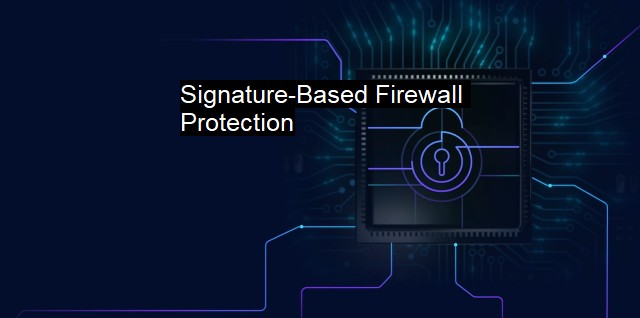What is Signature-Based Firewall Protection?
Understanding Signature-Based Firewall Protection: The Key Features and Critical Importance in Cybersecurity Defense Mechanisms
Signature-Based Firewall Protection is an important feature that enhances the security of networks, systems, and computer equipment. This feature is implemented with in the context of firewall and antivirus software.A firewall, in its simplest definition, is a network security device that monitors and controls incoming and outgoing network traffic based on an organization's predetermined security policies. It establishes a barrier between secured and controlled internal networks and untrusted external networks, such as the internet. A firewall can be hardware, software, or both based on the level of security required by an organization.
Signature-Based Firewall Protection is a type of detection method used by firewalls and antivirus software to identify potential threats. This type of security is also known as misuse detection because it seeks to detect patterns of traffic or application data presumed to be indicators of unauthorized activity.
These signatures are essentially patterns that correspond to known threats like viruses, Trojan horses, and certain activities that are linked to hacking. The signature definitions for these known threats are updated continuously by cybersecurity companies and are distributed through regular antivirus updates. Defense tactics are always evolving to match new threats, hence the need for constant updates on these signature definitions.
When a suspected data packet tries to pass through the firewall, its packet data is compared with the set of known signature patterns installed in the firewall's database. If the firewall identifies a match between the packet data and one of the signature patterns, it blocks or flags that packet as a security risk, and sends the network administrator an alert.
As notable as Signature-Based Firewall Protection is, implementing only this as a cybersecurity measure is not without weaknesses. It’s mainly because this method relies heavily on definitions for already known threats. It works on the premise of finding patterns in code that relate to existing viruses, malware, and hacking attempts. Unfortunately, this means that it is somewhat ineffective against zero-day exploits, which utilize hitherto unknown vulnerabilities. An sophisticated attacker could devise a technique not yet recognized by the signature database, and hence, would be able to evade detection.
To address these limitations, organizations often supplement Signature-Based Firewall Protection with other more proactive forms of protection methods like Heuristic or Behavior-Based Firewall Protection. These methods analyze the behavior of data packets against baseline normal behaviors instead of merely comparing data packets against a database of signature patterns.
Cybersecurity is critical, and Signature-Based Firewall Protection plays an essential role in safeguarding an organization's network. it necessarily needs to be combined with a variety of other more advanced methods to provide a comprehensive and robust protection system. By keeping their signature databases updated, practicing good digital hygiene, and augmenting Signature-Based Protection with other methods, organizations markedly improve their security posture and protect their systems against both known and unknown cyber threats. This increased vigilance, coupled with the evolution of firewall protection techniques, is instrumental in dealing with the constant and ever-changing world of cybersecurity threats.
Signature-Based Firewall Protection is an established method used in restricting malicious activities over a network. it should not be the only method utilized in a cybersecurity system due to its limitations. Every method of protection has its strengths and weaknesses but used in combination, these security mechanisms provide the multi-faceted defense system needed to overcome the increasingly sophisticated tactics employed by cyber attackers.

Signature-Based Firewall Protection FAQs
What is signature-based firewall protection?
Signature-based firewall protection is a security mechanism that identifies and blocks malicious traffic by comparing it against a database of known attack signatures. It works by analyzing network traffic and matching it with a pre-defined set of signatures or patterns that are associated with known cybersecurity threats.How does signature-based firewall protection differ from other types of firewall protection?
Signature-based firewall protection is different from other types of firewall protection in that it focuses specifically on identifying and blocking known malware attacks. Other types of firewall protection, such as behavior-based and reputation-based, use different techniques to detect and block potential threats.What are the benefits of using signature-based firewall protection?
The main benefit of using signature-based firewall protection is that it can detect and block known malware attacks with a high degree of accuracy. This can help to prevent the spread of malware and other types of cyber attacks, thereby reducing the risk of data breaches and other security incidents. Additionally, signature-based firewall protection is relatively easy to implement and can be integrated with other security tools to provide a comprehensive security solution.What are the limitations of using signature-based firewall protection?
One major limitation of using signature-based firewall protection is that it can only detect and block known malware attacks. If attackers use new or unknown attack methods, signature-based firewall protection may not be able to detect or stop them. Additionally, maintaining an up-to-date database of attack signatures can be challenging, as attackers are constantly creating new threats and evolving their techniques to evade detection. As such, signature-based firewall protection should be used in conjunction with other types of security measures to provide comprehensive protection against cyber attacks.| | A | | | B | | | C | | | D | | | E | | | F | | | G | | | H | | | I | | | J | | | K | | | L | | | M | |
| | N | | | O | | | P | | | Q | | | R | | | S | | | T | | | U | | | V | | | W | | | X | | | Y | | | Z | |
| | 1 | | | 2 | | | 3 | | | 4 | | | 7 | | | 8 | | |||||||